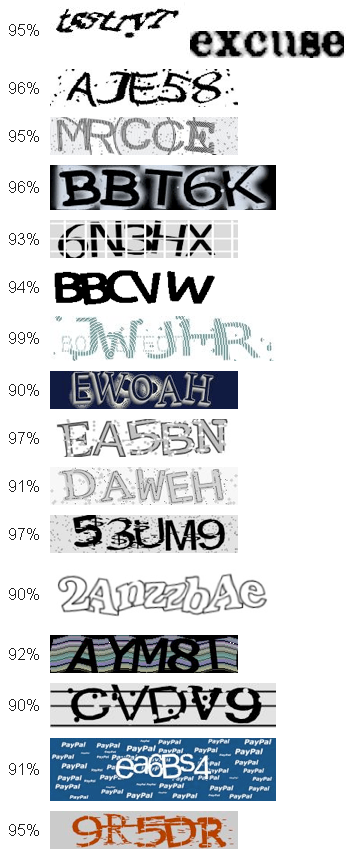Vicarious AI breaks CAPTCHA ‘Turing test’
October 28, 2013
[+]
Vicarious, a
startup developing artificial intelligence software, today announced
that its algorithms can now reliably solve modern CAPTCHAs (Completely
Automated Public Turing tests to tell Computers and Humans Apart).
Average
recognition accuracy (per character) claimed for the Vicarious
algorithms for different CAPTCHA styles (credit: Vicarious)
Stanford University researchers have suggested that a CAPTCHA scheme (which are used by websites to verify that a visitor is human by asking them to transcribe a string of distorted letters) should be considered “broken” if an algorithm is able to reach a precision* (fraction of CAPTCHAs answered correctly) of at least 1% [1].
Breaking CAPTCHAs
Vicarious claims they can go way beyond that by leveraging core insights from machine learning and neuroscience, saying its AI algorithms achieve success rates up to 90% on modern CAPTCHAs.
“This advancement renders text-based CAPTCHAs no longer effective as a Turing test,” according to a Vicarious statement. (The Stanford study calls it a “reverse Turing test” because CAPTCHAs are intended to allow a website to determine if a remote client is human or not.)
“Recent AI systems like IBM’s Watson and deep neural networks rely on brute force: connecting massive computing power to massive datasets,” said Vicarious cofounder D. Scott Phoenix.
“This is the first time this distinctively human act of perception has been achieved, and it uses relatively minuscule amounts of data and computing power. The Vicarious algorithms achieve a level of effectiveness and efficiency much closer to actual human brains.”
A brain-like vision system
“Understanding how the brain creates intelligence is the ultimate scientific challenge. Vicarious has a long term strategy for developing human level artificial intelligence, and it starts with building a brain-like vision system,” said Vicarious cofounder Dileep George, PhD, who was formerly Chief Technology Officer at Numenta, a company he cofounded with Jeff Hawkins and Donna Dubinsky (Palm Computing, Handspring) while completing his PhD at Stanford University.
“Modern CAPTCHAs provide a snapshot of the challenges of visual perception, and solving those in a general way required us to understand how the brain does it.”
Solving CAPTCHA is the first public demonstration of the capabilities of Vicarious’ Recursive Cortical Network (RCN) machine learning software, which is based on the computational principles of the human brain. (Vicarious says it does not plan to release RCN or its algorithms publicly).
Vicarious’ RCN technology is a visual perception system that interprets the contents of photographs and videos in a manner similar to humans. “Although still many years away, the commercial applications of RCN will have broad implications for robotics, medical image analysis, image and video search, and many other fields,” according to a Vicarious statement.
* The paper and Vicarious use “accuracy” and “precision” interchangeably.
(¯`*• Global Source and/or more resources at http://goo.gl/zvSV7 │ www.Future-Observatory.blogspot.com and on LinkeIn Group's "Becoming Aware of the Futures" at http://goo.gl/8qKBbK │ @SciCzar │ Point of Contact: www.linkedin.com/in/AndresAgostini
 Washington
Washington